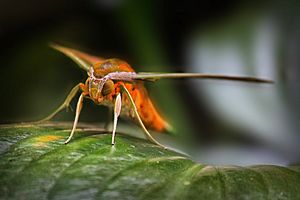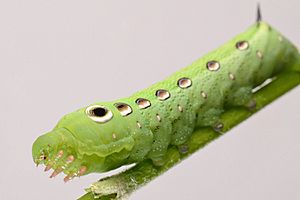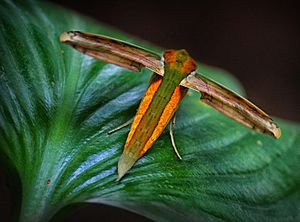Tersa sphinx facts for kids
The tersa sphinx (Xylophanes tersa) is a type of moth known for its fast flight. It belongs to the Sphingidae family, often called sphinx moths or hawk-moths. This moth was first described by the famous scientist Carl Linnaeus in 1771.
You can find the tersa sphinx in many places. It lives across the United States, from Massachusetts down to Florida and west to Arizona. It also flies through Mexico, the Caribbean, Central America, and into parts of South America like Brazil and Argentina. Sometimes, it even travels as far north as Canada!
Quick facts for kids Tersa sphinx |
|
|---|---|
 |
|
 |
|
| Scientific classification | |
| Synonyms | |
|
Contents
What the Tersa Sphinx Looks Like
The tersa sphinx moth has a wingspan of about 60 to 80 millimeters. That's about 2.3 to 3.1 inches wide!
Forewings and Hindwings
The top side of its front wings (forewings) is a light brown color. Near the base of these wings, you might see a pretty lavender-gray shade. Dark brown lines crisscross these wings. The back wings (hindwings) are dark brown. They have a cool band of whitish, wedge-shaped marks. These marks look a bit like triangles.
Life Cycle of the Tersa Sphinx
Tersa sphinx moths fly at different times of the year depending on where they live. In cooler northern areas, you can see adults from May to October. Farther south in the U.S., they fly for a longer time, from February to November. In tropical places, they can be found flying all year round!
Generations of Moths
In the north, there is usually one group of moths (one generation) each year. But in warmer places like Florida and Louisiana, there can be several generations. This means new moths hatch and grow throughout the year.
What Tersa Sphinx Moths Eat
Adult tersa sphinx moths are important pollinators. They drink nectar from many different flowers. Some of their favorite flowers include Lonicera, Mirabilis jalapa (also called the four o'clock flower), and Asystasia gangetica.
What Tersa Sphinx Caterpillars Eat
The young tersa sphinx moths, called larvae or caterpillars, eat leaves from various plants. They like plants such as Borreria, Catalpa, Manettia, and Pentas species. They also munch on Spermacoce glabra, Hamelia patens, Hedyotis nigricans, Heimia salicifolia, Psychotria microdon, Psychotria nervosa, and Inga vera.
See also
 In Spanish: Xylophanes tersa para niños
In Spanish: Xylophanes tersa para niños


